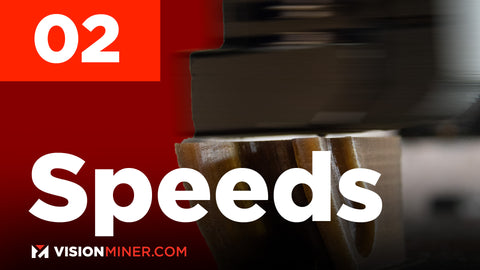
Today, we’re going over tuning basics and how to tune your print to get the perfect part every single time.
Our second video covers dialing in how fast your nozzle moves around your part, AKA ‘Speed’. This affects how your printer lays down each layer of the part.
While we do love having prints done quick and fast, quality is always affected in some way by the speed of your printer. The general rule of thumb for 3D printing is slower speeds will yield higher quality.
The speed you go with depends on what part you are creating. Do you need a strong part where looks don't matter but quick printing time does, or do you want a part with perfect dimensional accuracy and little to no surface blemishes.
The trade-off between speed and quality is a matter of the hardware in a 3D Printer. While printing, a machine has to move the nozzle head around the print area, creating momentum and force. The faster you go, the harder each stop of the nozzle becomes in order to reverse the head’s momentum. This stopping is what causes jerky movement.
On a printer going fast, accuracy and smoothness are hard to maintain. However, going slower results in steadier movements where the printer head can handle curves and corners with ease and perfection. Additionally, material choice is also a factor in quality versus swiftness.
With any print slicer software, you can adjust speed in the settings. As you hit slice, your program will inform you how long the print will take. So, if you need a part by tomorrow morning but it will take 26 hours to complete, you can attempt faster speeds under different settings such as layer height, material choice, etc.
Based on that, you can perform tests with calibration parts between different speed settings. In general, PLA prints at around 60 millimeters per second on most 3D printers. Naturally, there is a lot of experimentation to change this, but as of early 2019, most materials need a speed ranging from 40 millimeters per second on the low end to 100 millimeters per second at the high end.
With advanced materials such as PEEK and PEI, Vision Miner recommends a more-involved experimentation process when calibrating your printer as these materials’ properties demand different speeds for different part geometries. There will be a difference when printing in PEEK, for example, if you need a vase-mode part versus a solid block part.
If you are just starting out, stick to 40 millimeters on PLA as a safe area to begin. Once you gain more experience in speeds and other materials, you can then attempt different settings beyond that initial 40 millimeter mark.
If you’re interesting in learning more about tuning, check back on the blog for more updates and visit our YouTube channel for more videos!



Leave a comment